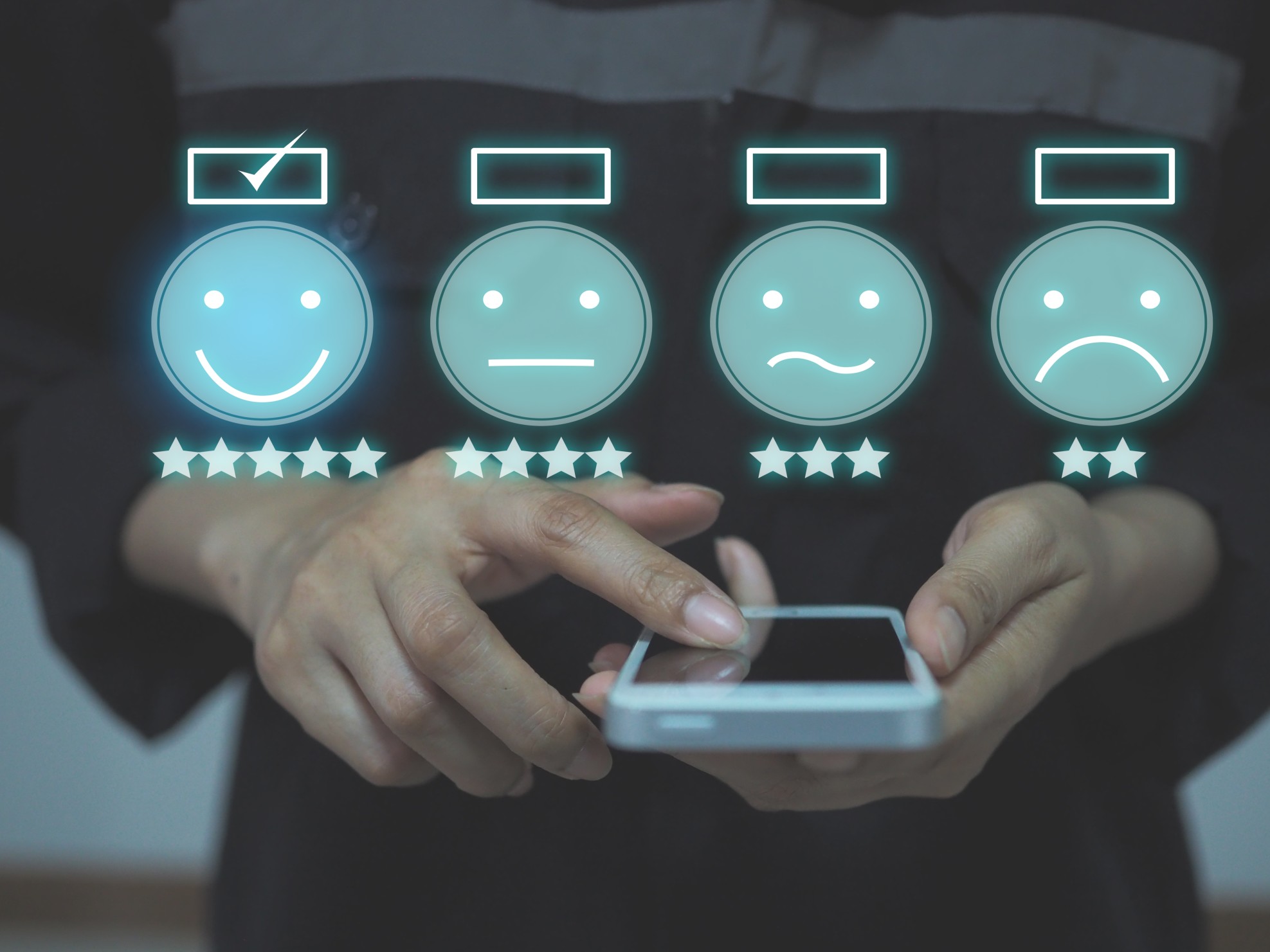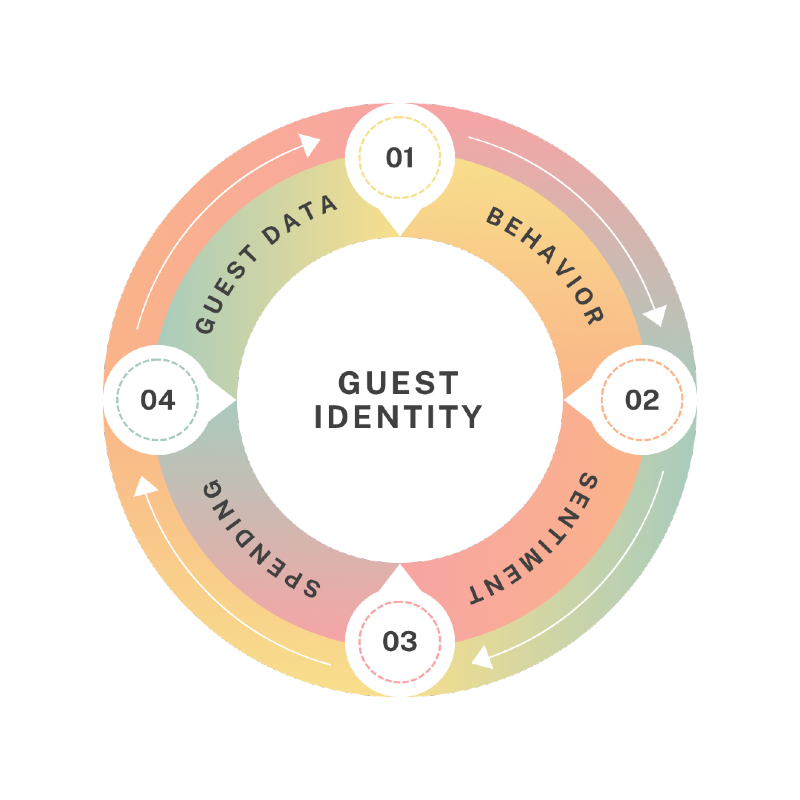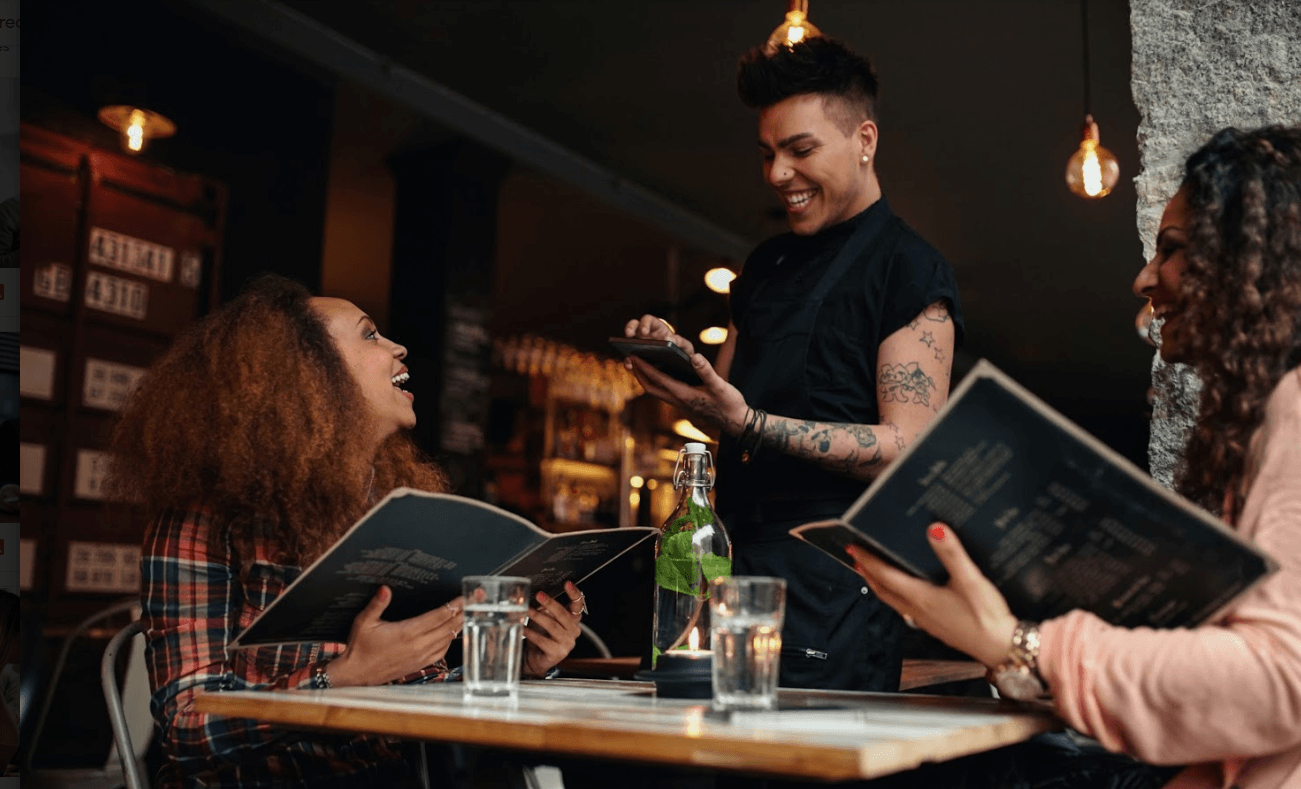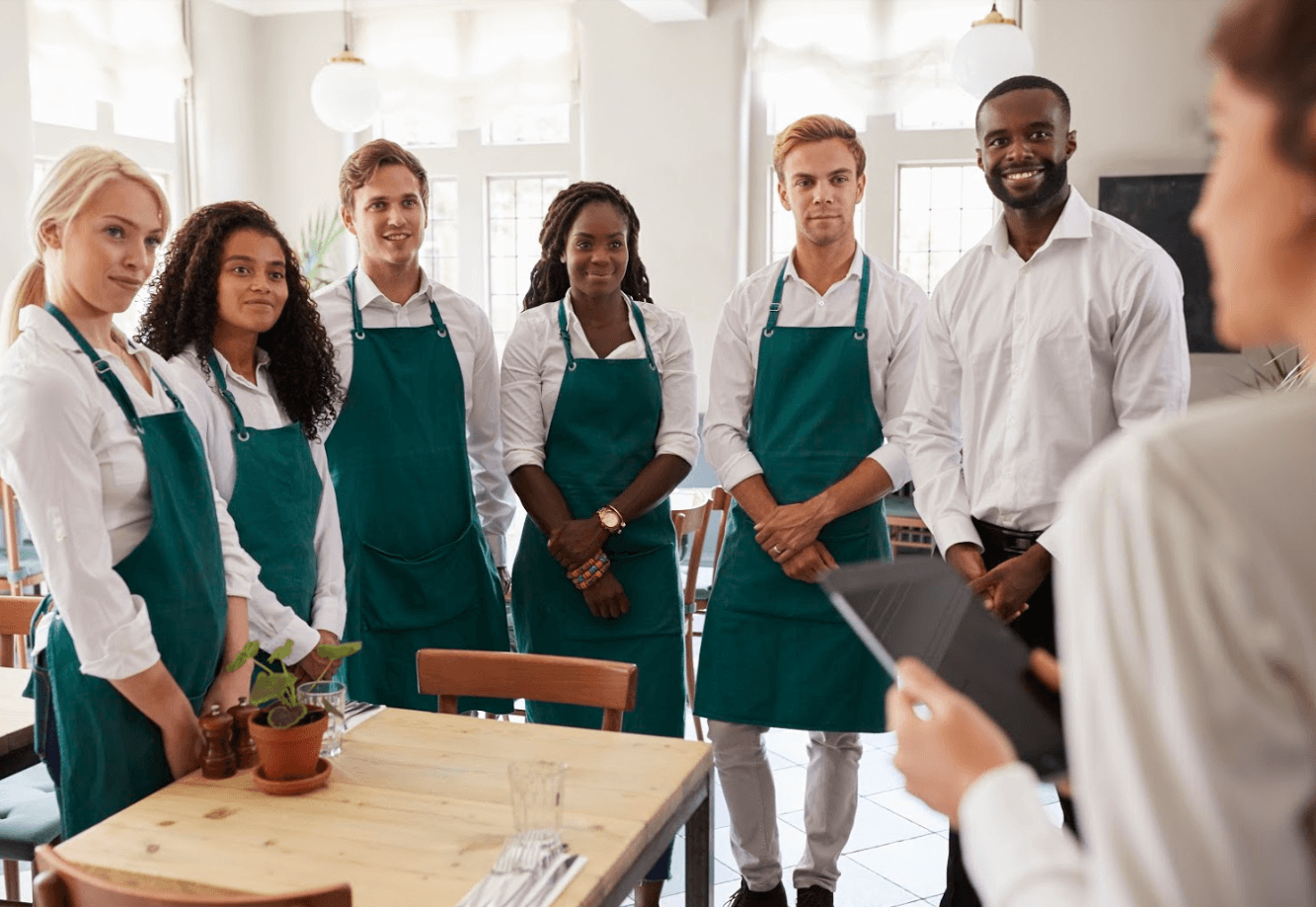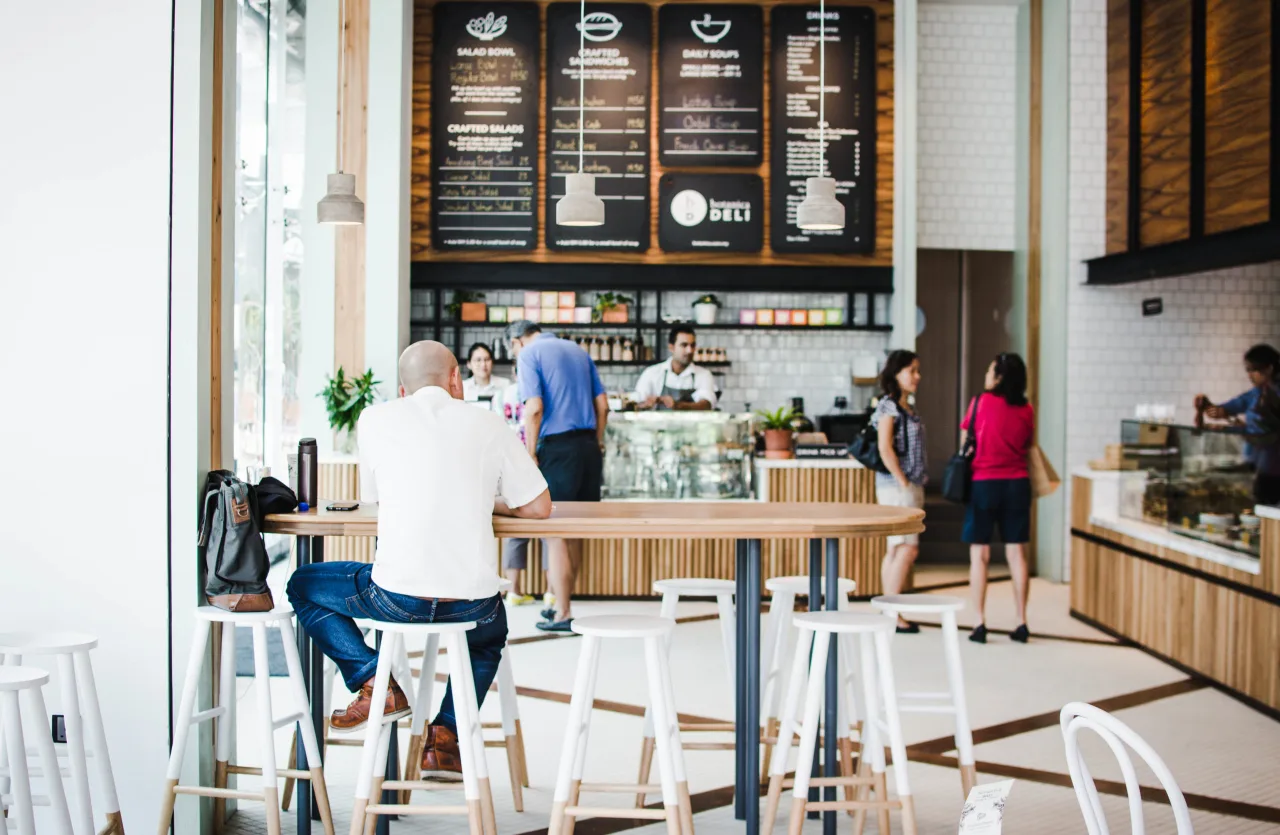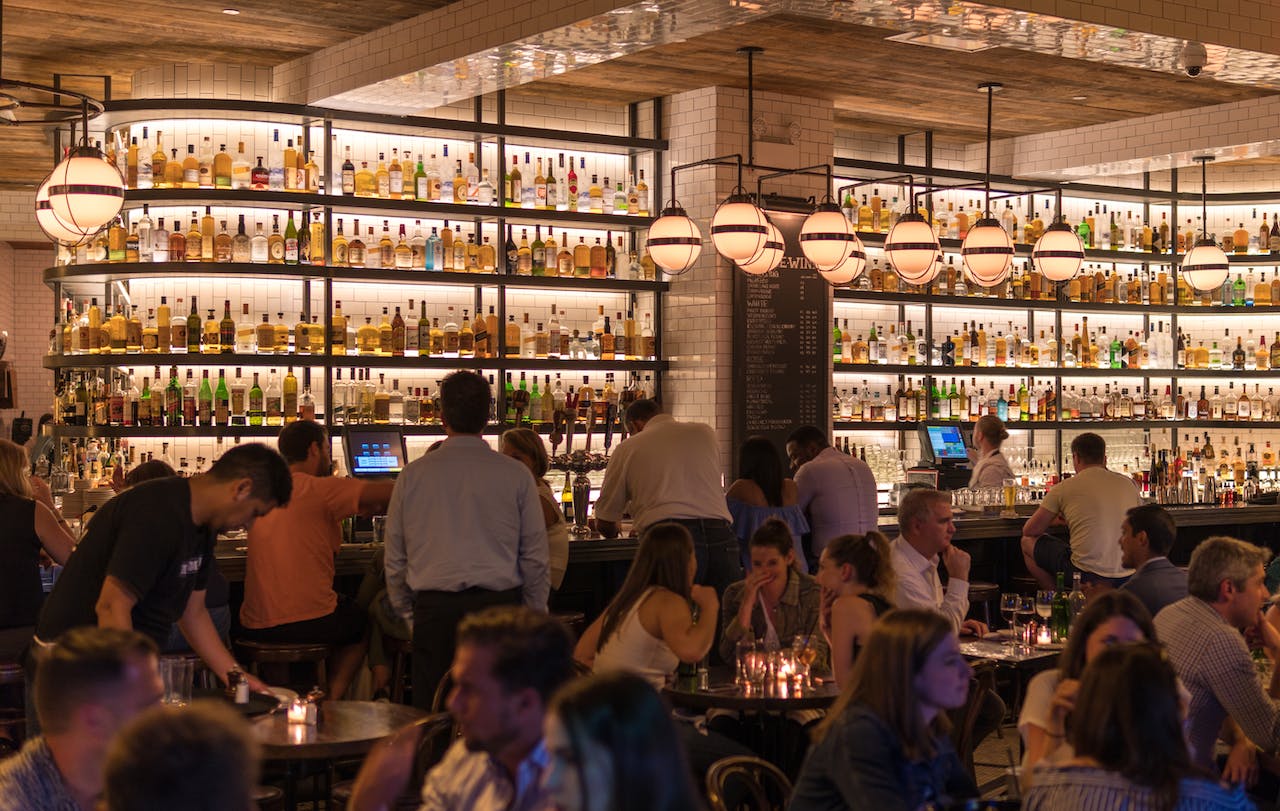33 Restaurant Marketing Strategies to Boost Revenue in 2025: Proven Strategies to Grow Your Business
Explore expert restaurant marketing strategies using customer data platforms, AI automation, and reputation management to increase guest retention and drive revenue growth.
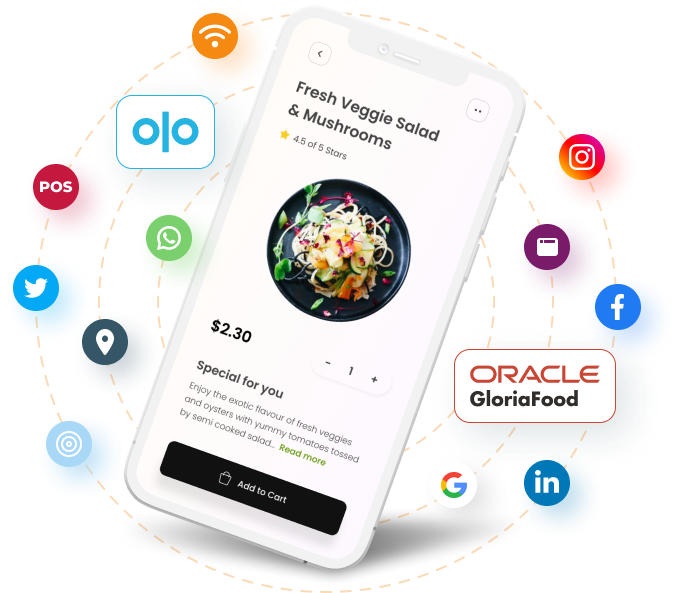
Scroll to explore
33 Restaurant Marketing Ideas, Tips, and Trends for 2025
Want to fill more seats, increase loyalty, and grow revenue in 2025? You don’t need another gimmick—you just need a deep understanding of your guests.
The best restaurant marketing today starts with guest identity: knowing each diner’s behavior across your location and platforms, sentiment, spend, and details like their name, email, phone number, birthday, anniversary, and ZIP code.
When you unify that data, you can deliver unforgettable hospitality across every channel—email, SMS, WiFi, loyalty systems, reservations, online ordering, and at your locations. The result? Lower costs. Higher frequency. Stronger lifetime value.
This guide delivers 33 proven restaurant marketing strategies built on that principle. Whether you’re a founder, operator, GM, or marketer, each one is a play you can run today.
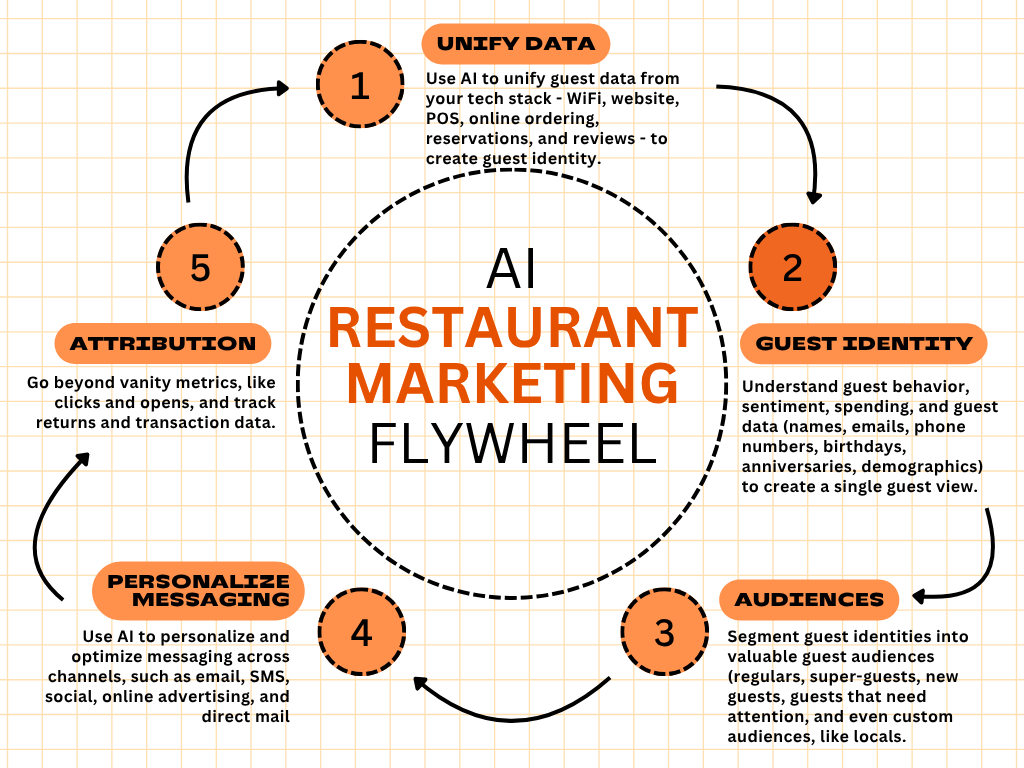
1. Use AI to Save Time and Win Back Guests Automatically
AI helps you spot at-risk guests, send them offers, and auto-reply to reviews—all while keeping your brand voice intact.
✅ Use AI to personalize messaging, auto-tag sentiment in reviews, and recover lost customers with smart triggers.
AI-driven insights optimize campaign timing and content, boosting efficiency and driving higher revenue through targeted marketing strategies.
2. Build a Guest Data Platform That Fuels Every Channel
A restaurant Customer Data Platform (CDP) collects data from WiFi, POS, online orders, websites, reviews, and reservations, turning fragmented information into a comprehensive guest profile.
✅ Group guests by frequency, value, behavior, or sentiment. Then, send relevant offers.
This allows you to tailor marketing efforts to specific customer groups, increasing engagement and loyalty through personalized offers.
3. Segment Smarter. Speak Directly.
Stop blasting emails. Segment guests by behavior, preferences, or visit timing with data-powered customer segmentation.
✅ Example: Send a “We Miss You” campaign only to weekday lunch regulars who haven’t visited in 3 weeks.
By analyzing and segmenting by preferences and behaviors, restaurants can optimize promotions and improve guest experiences, driving repeat visits and higher revenue.

4. Turn Guest WiFi Into a Marketing Engine
WiFi logins (or even proximity tracking) can reveal guest behavior without staff effort.
✅ Use dwell time, repeat visits, and login data to power personalized follow-ups.
Let your guest WiFi do the data collection for you, easily collecting more information for your customer data platform.
5. Capture Gold Through Online Orders
Online ordering gives you deep data on online ordering habits, items, and spend.
✅ Re-market to past online guests with tailored reorder messages or upsell campaigns.
Online ordering data provides restaurants with valuable insights into customer preferences and purchasing patterns, enabling targeted marketing campaigns that drive repeat orders.
6. Use Reservation Data for Precision Offers
Reservations are more than collecting guest contact data. Reservations also reveal party size, frequency, and even special occasions.
✅ Send anniversary offers or first-time guest follow-ups right after their visit.
By analyzing booking patterns, restaurants can optimize promotions and staffing, improving customer experiences and maximizing revenue.
7. Reviews = Raw Feedback Gold
Monitor all major platforms to see what your guests actually think. Leverage the voice of your guest and operationalize customer sentiment with your team.
✅ Use review trends to shape operations AND feed high-performing messaging.
Leveraging positive feedback in promotional campaigns can enhance brand reputation and encourage repeat visits, while addressing negative sentiment can improve customer satisfaction and loyalty.
8. SMS Isn’t Optional. It’s a Revenue Channel.
98% open rates. Real-time urgency. That’s SMS marketing.
✅ Send birthday rewards, weather-based promos, or flash discounts.
SMS marketing enables restaurants to send timely, personalized promotions directly to customers’ phones, driving immediate engagement and increasing foot traffic during slow periods.
By leveraging SMS for targeted offers and reminders, restaurants can boost customer loyalty and repeat visits with high open rates and quick response times.
9. Make Your Website a Conversion Machine
Most guests hit your website before they visit or order online. Optimize it for reservations, menus, online orders, and opt-ins.
✅ Add email/SMS signups, loyalty joins, and menu search to drive action.
Leveraging your website for marketing allows for the creation of a branded platform to showcase menus, promotions, and customer reviews, attracting new diners and encouraging repeat visits.
By optimizing the website with SEO and integrating online ordering or reservation systems, restaurants can drive traffic, capture guest data, and enhance engagement for targeted marketing campaigns.
10. Rank Higher With Local SEO
Claim your Google Business profile. Keep photos, menu, and hours fresh. Respond to reviews.
✅ Use reviews and keywords to climb local rankings.
Local SEO helps your restaurant website attract nearby customers searching for dining options, increasing foot traffic and sales.
By optimizing for local search terms and Google My Business, you also build trust and visibility within your community, giving you a strong edge over competitors.
11. Trigger Campaigns Automatically
Don’t wait to send offers. Trigger them based on guest behavior (from your locations or guest facing platforms or events) with marketing automation.
✅ Examples: Birthday texts, post-visit surveys, or loyalty milestones.
Behavior-driven marketing allows restaurants to personalize their messaging and offers based on customer dining patterns, purchase history, and preferences, leading to higher conversion rates and increased customer lifetime value.
By analyzing behavioral data such as order frequency, menu preferences, and visit timing, restaurants can optimize their marketing spend by targeting the right customers with relevant promotions at the most effective moments, ultimately driving more repeat business and higher average order values.
12. Know Which Campaigns Drive Dollars
Track redemptions from offers. See who returned. Know what worked.
✅ Connect email/SMS clicks to actual in-store or online activity.
Tracking marketing campaigns enables businesses to measure return on investment (ROI) and identify which channels, messages, and tactics generate the most revenue, allowing them to allocate their marketing budget more effectively and eliminate wasteful spending.
By monitoring campaign performance in real-time, businesses can quickly optimize underperforming campaigns, scale successful ones, and make data-driven decisions that improve overall marketing effectiveness and profitability.
13. Keep Loyalty Simple—and Everywhere
Your loyalty program should be easy to join, rewarding to use, and deeply integrated.
✅ Combine WiFi, POS, website, online ordering, reservations, and reviews to track and reward effortlessly. Widen your net.
A restaurant loyalty program boosts customer retention by rewarding repeat business, encouraging guests to return more frequently.
It also provides valuable customer data, allowing businesses to tailor marketing efforts and improve personalized experiences, leading to increased sales and customer satisfaction.
14. Win Attention with Strong Social Content
Guests want to engage visually. Post behind-the-scenes, staff highlights, and real dishes.
✅ Use Reels, Stories, and location hashtags to expand reach.
Using visually engaging social media helps restaurants attract attention and showcase their unique menu items, ambiance, and special events, leading to increased brand awareness.
It also fosters guest engagement, building a loyal online community that can drive foot traffic and word-of-mouth referrals.
15. Build Community with Facebook Contests and Groups
Polls, contests, and community engagement keep fans coming back.
✅ Ask fans to name a new dish or vote for next month’s special.
Contests and social media groups help restaurants increase engagement by encouraging guests to participate, share experiences, and invite others, expanding their reach organically.
These interactive strategies also foster a sense of community, strengthening brand loyalty and driving both online and in-store traffic.
16. Turn Instagram Into a Viral Menu
Photos, Reels, and influencer tags help amplify your reach.
✅ Use UGC (user-generated content) and geo-tags to increase local visibility.
Using Instagram for UGC allows restaurants to build trust and authenticity by showcasing real customer experiences and testimonials.
It also expands brand visibility as guests share their posts, attracting new followers and potential guests through word-of-mouth marketing.
17. Use Twitter/X for Instant Announcements
Limited-time offers, closures, or special hours? Post it fast.
✅ Respond to mentions to show attentiveness and build goodwill.
Twitter/X is an ideal platform for restaurants to make instant, time-sensitive announcements, such as limited-time promotions, special events, or menu updates, driving immediate customer action.
Its real-time nature also helps businesses stay relevant and engaged with their audience, fostering a sense of urgency and increasing foot traffic or online orders.
18. Run Paid Ads That Actually Work
Use guest lists or audiences of your super guests or regulars for Facebook/Instagram lookalikes or Google retargeting.
✅ Upload top spenders to create high-value lookalike audiences.
Paid advertising with lookalike and retargeting campaigns allows restaurants to reach new customers who resemble their best existing ones, increasing the likelihood of conversion.
Retargeting also ensures that past website visitors or engaged users are reminded of the brand, boosting the chances of returning customers and higher sales.
19. Reconnect with Past Visitors
Remarketing campaigns let you re-engage those who’ve ordered or visited before.
✅ “We haven’t seen you in a while” paired with a unique personalized offer = ROI.
Remarketing campaigns help restaurants re-engage customers who have previously interacted with their brand but didn’t complete a desired action, such as making a reservation or placing an order.
By keeping the restaurant top-of-mind, these campaigns increase the likelihood of conversion, driving repeat business and boosting overall revenue.
20. Automate Reputation Management
Save 10–20 hours/month by automating review responses and flagging sentiment trends.
✅ Use AI to suggest brand-safe replies instantly, and build your online discoverbility.
AI-driven reputation management helps restaurants automatically monitor and respond to online reviews, ensuring timely, personalized responses that enhance customer satisfaction.
This automation reduces hours of manual workload while improving the restaurant’s online presence, leading to stronger customer loyalty and a more positive brand image.
21. See All Reviews in One Dashboard
Don’t bounce between platforms. Aggregate, analyze, and respond to reviews across Google, Yelp, TripAdvisor, Facebook, OpenTable, Tock, and more.
✅ Filter by location, rating, or keyword to spot issues fast.
Aggregating all reviews from multiple sites into one single dashboard allows restaurants to efficiently monitor and manage their online reputation from a centralized location at scale.
This streamlined approach saves time, improves responsiveness to guest feedback, and helps identify trends or areas for improvement, leading to enhanced guest satisfaction and business growth.
22. Let AI Write Review Responses for You
Pre-loaded templates and brand voice configuration ensure consistency.
✅ Use AI to reply instantly—or edit for personal flair.
Using AI tools to respond to reviews enables restaurants to provide quick, consistent, and personalized replies to guest feedback, even during busy times.
This enhances customer engagement, improves brand perception, and ensures that no review goes unnoticed, ultimately boosting online reputation and customer loyalty.
23. Showcase Ratings as Social Proof
Add live review widgets to your website to build trust before they visit.
✅ Feature average star ratings from Google or Facebook with one line of code.
Showcasing social proof, such as customer reviews, ratings, and user-generated content, builds trust and credibility with potential guests, influencing their decision to visit.
It also strengthens brand loyalty by validating the restaurant’s quality and service, encouraging both repeat and new customers to engage with the brand.
24. Optimize Listings for Guest Discovery
Update listings regularly. Respond to reviews. Post new photos.
✅ Outdated hours = lost traffic. Update every week, and especially for holidays.
Keeping a restaurant’s business listing up to date ensures accurate information is available to potential guests, such as hours, location, and menu, which helps drive foot traffic and online orders.
It also boosts visibility on search engines and review platforms, improving the chances of attracting new patrons and retaining existing ones.
25. Use Sentiment Analysis to Improve Operations
Track customer sentiment and trending keywords in reviews: “cold food,” “friendly staff,” “slow service.”
✅ Fix issues faster. Promote what’s working. Empower your team.
Sentiment analysis allows restaurants to gain valuable insights into customer feelings and experiences, helping identify strengths and areas for improvement in service and offerings.
By addressing negative feedback promptly and capitalizing on positive sentiments, restaurants can enhance customer satisfaction, boost retention, and refine their operations for better overall performance.
26. Automate Feedback and Recovery Loops
Post-visit surveys help catch issues before they hit Google.
✅ Send follow-ups based on scores: low = recovery offer, high = bring a friend offer.
Automating feedback and recovery loops allows restaurants to quickly identify and address customer concerns, preventing negative experiences from escalating.
This proactive approach not only improves customer satisfaction but also fosters loyalty by demonstrating a commitment to continuous improvement and personalized service.
27. Keep Listings Fresh and Synced
Google Business, Facebook, Apple Maps—update hours, links, and services.
✅ Use one dashboard to push updates across platforms.
Keeping business listings in sync across multiple platforms ensures consistent and accurate information, reducing customer confusion and increasing trust.
This consistency also improves search engine rankings and enhances the restaurant’s visibility, making it easier for potential guests to find and engage with the brand.
28. Test Traditional Media—Smartly
Only advertise in publications that match your regular guest demographics.
✅ Use CDP data to find the overlap.
Using a customer data platform (CDP) allows restaurants to analyze guest behavior and preferences, enabling the creation of highly targeted advertising audiences.
This results in more efficient marketing campaigns, improved return on investment (ROI), and increased guest acquisition by reaching the right people with personalized, relevant offers.
29. Let Local Influencers Tell Your Story
Invite micro-influencers in for tastings. Let them post authentic content.
✅ Focus on local voices your ideal guests already trust.
Employing influencers allows restaurants to tap into new, engaged audiences and build credibility through authentic endorsements.
Influencers can drive brand awareness and customer trust, leading to increased foot traffic, online orders, and social media engagement.
30. Go Touchless Where It Counts
QR menus, mobile pay, and online ordering increase convenience and opt-ins.
✅ Every digital interaction is a data point you can use.
Going touchless in a restaurant enhances guest safety and convenience by minimizing physical contact.
It also improves operational efficiency, allowing for smoother ordering, payment processes, and overall customer experience, leading to higher satisfaction and repeat business.
31. Turn Guest Feedback Into Marketing Gold
Guests are already telling you what matters. Use their words in your campaigns.
✅ Highlight real 5-star review snippets in your emails or ads as social proof.
Using guest feedback for marketing allows restaurants to highlight positive customer experiences, building authenticity and trust with potential diners.
It also provides valuable insights to refine offerings, tailor promotions, and improve guest engagement, which ultimately drives higher traffic and stronger brand loyalty.
32. Identify and Target High-Value Audiences
Not all guests are equal. Segment audiences by spend, visit count, or menu preferences.
✅ VIP brunch crowd? Create a custom audience just for them.
A restaurant customer data platform helps restaurants identify high-value audiences by analyzing purchasing behavior, preferences, and visit frequency, allowing for more precise targeting.
This enables the creation of personalized marketing campaigns that drive repeat business, increase customer loyalty, and maximize return on investment.
33. Keep Your Brand Voice Consistent Everywhere
Your colors, fonts, tone—they matter. Use your brand kit in every touchpoint.
✅ Store it in your system so all templates reflect your style.
Maintaining a consistent brand voice across all customer touchpoints helps build trust and recognition, ensuring that customers have a unified experience with the restaurant.
This consistency strengthens the brand’s identity, enhances customer loyalty, and improves overall brand perception, leading to increased engagement and repeat business.
Final Thought: Know Your Guest. Win Their Loyalty.
Behind every visit is a real person. When you understand who they are—how often they come, what they love, how much they spend, and how they feel—you can deliver hospitality that goes far beyond the meal.
That’s the power of unified guest identity. When you combine behavior, sentiment, spend and guest details into one system, you unlock the ability to send the right message, at the right time, on the right channel—with minimal effort.
Yes, you could stitch this together with multiple tools… or you could simplify with one system that:
- Connects all your tech (WiFi, POS, online ordering, reservations, reviews, etc.)
- Builds rich guest profiles automatically
- Suggests and launches marketing campaigns
- Automate marketing tasks with a click of a button – forever
- Tracks ROI back to the guest and visit
That’s a Restaurant Marketing Operating System. And it’s how you turn one-time visitors into lifetime regulars.
Curious how Bloom Intelligence can elevate your guest experience and restaurant marketing? Click Here for a Free Demo.
SAVE TIME, INCREASE CUSTOMER LIFETIME VALUES, CREATE NEW CUSTOMERS
What our happy customers
are saying
“SaaS that covered so many bases for us instead of having to use multiple software products. Bloom Intelligence has simplified our responses to reviews, customer feedback, and more. I highly recommend Bloom Intelligence.”
Robert Sanderson
“Bloom Intelligence really is a step ahead in terms of marketing software and metrics. Their product is reliable, fast and innovative and has helped the company I work for really grow.”
John Marchetti
“Working with Bloom Intelligence has been amazing. They assist you every step of the way and work with you hand in hand to make sure you are optimizing your advertising potential. We are excited to use this tool to help learn more about our customers so that we can personally engage with them and understand our strengths/weaknesses.”
Ariel Ramirez
“In these challenging times, it has been a pleasure working with Bloom Intelligence to help facilitate our service offering to our clients. They were extremely responsive and provided support to mitigate risk and minimize revenue loss. Great partner!”
Stefan Kim
“We’re extremely pleased with the wealth of customer data that we’re able to gather, at a very attractive price. In addition, we’re able to communicate our new product promotions by using the landing page as a digital billboard. A “no-brainer” for anyone working with limited Marketing $$.”
Bob Cross, Vice President of Operations
How to Market a Restaurant: FAQs
What is the best marketing strategy for restaurants?
Of all the restaurant marketing strategies, perhaps the most effective strategy is using a WiFi marketing and analytics platform. It allows you to collect customer contact information, segment your customer list, create targeted, personalized messaging, and remarket to them for maximum results.
What is restaurant remarketing?
Restaurant remarketing is a powerful way to connect with visitors to your website or customers who have logged into your WiFi. It allows you to send targeted advertising, and behavior-driven promotions to those people through online advertising or email marketing. It’s a key marketing concept that should be a primary focus of restaurant owners and marketers.
What is restaurant marketing segmentation?
Restaurant customer segmentation refers to the process of subdividing a customer base into specific groups based on similar demographics, psychographics, and/or various behavior data points. This information can guide restaurant marketing professionals when developing new marketing campaigns for each group or optimizing existing ones to personalize the customer experience online or at their physical locations.
How do you use smart coupons to market a restaurant?
The best way to implement a digital smart coupon program is to use a WiFi marketing and analytics platform like Bloom. The platform allows you to easily create and send customers a unique, one-time-use code that they can redeem on their next visit. The coupon is stored on their mobile device.
The Power of AI Restaurant Marketing with Bloom

Optimize retail &
business operations

Track attribution of
customer campaigns

Trigger marketing
campaigns based on
marketing presence

Measure the health
of corporate & franchisee
locations

Compare locations or
groups of locations to
quickly identify opportunities
or threats
Are you ready to grow
your restaurant business with
Bloom?
behavior, automates campaigns, improves reputation,
and builds guest loyalty.
It’s time to start leveraging your guest data to gain
a competitive edge. Then watch your profits grow.



